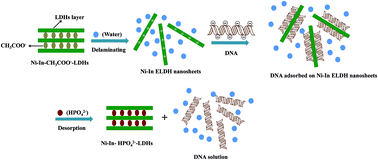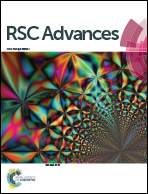Two-dimensional ultrathin nanosheets of Ni–In-layered double hydroxides prepared in water: enhanced performance for DNA adsorption†
Abstract
This work describes a facile approach for the delaminating of Ni–In-layered double hydroxides (LDHs) by the intercalation of acetate anions in the LDHs gallery using co-precipitation method. The acetate-intercalated Ni–In LDHs exhibited swelling behavior in water and delaminated into semitransparent suspensions on the action of water. The transmission electron microscopy (TEM) and atomic force microscopic (AFM) observations revealed the formation of unilamellar LDHs nanosheets. This simple method did not need reflux at high temperatures, overcoming the deficiency of using organic solvents, resulting in a steady colloidal suspension of 2D nanosheets. The unique properties of 2D ultrathin nanosheets with full access to the positively charged activity sites make them attractive in terms of the improvement of DNA adsorption. The effect of dosage on the adsorption of DNA and the adsorption isotherm were investigated in detail. The equilibrium data were found to be well described by both the Langmuir and Freundlich models. Based on the mechanism of adsorption, the adsorption sites of exfoliated nanosheets can be easily occupied by highly negatively charged small anions through electrostatic interactions. The adsorbed DNA can be released via the addition of a hydrogen phosphate solution.


 Please wait while we load your content...
Please wait while we load your content...